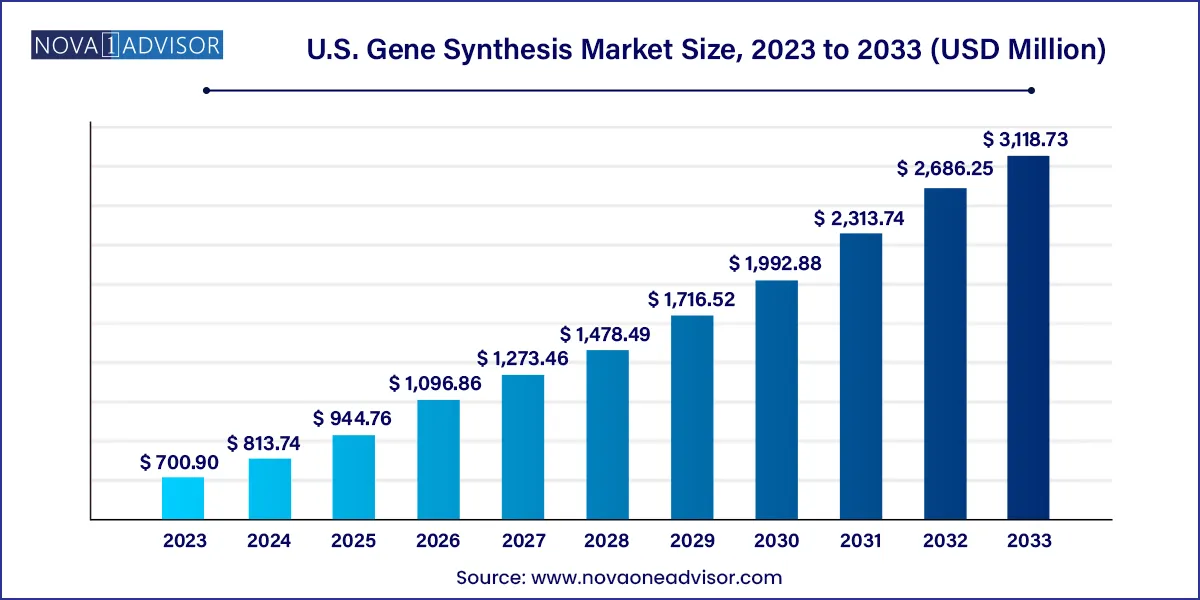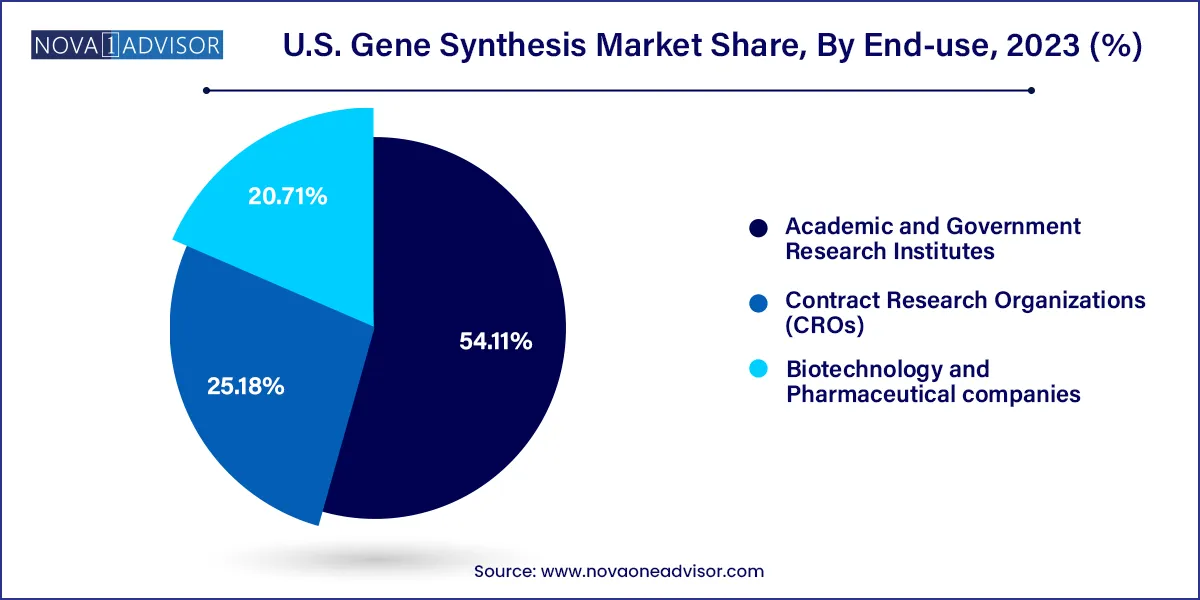The U.S. Gene Synthesis market size was valued at USD 700.90 million in 2023 and is projected to surpass around USD 3,118.73 million by 2033, registering a CAGR of 16.1% over the forecast period of 2024 to 2033.

Key Takeaways:
U.S. Gene Synthesis Market Growth
The market growth is significantly influenced by the presence of several key market participants offering gene synthesis services and increasing interest of major biotechnology and pharmaceutical companies in gene & cell therapy development. The expanding field of synthetic biology and increasing application areas in molecular biology arena are opportunistic for market growth. Furthermore, presence of high number of contract research organizations (CROs) providing gene synthesis services is also expected to drive the market growth. For instance, GenScript offers a wide range of services, including custom gene synthesis services and antibody drug development services.
Furthermore, nonprofit organizations including BioBricks confirm the accessibility of synthetic biology technologies for humanitarian purposes. OpenWetWare and other synthetic biology forums act as data sharing platforms and help in delivering researchers with conceptual training. Establishment of such forums and organizations encourages researchers to opt for and study synthetic biology theories as well as develop advanced technologies, which is also a notable growth driver for this market.
In 2023, U.S. gene synthesis market accounted for a market share of over 34% in the global gene synthesis market. Companies are increasingly introducing advanced gene synthesis products and services, which drives the market growth. For instance, Synbio Technologies LLC offers a comprehensive portfolio of gene synthesis services to fulfill customers’ DNA manufacturing needs. The country’s market growth is strengthened by its highly efficient institutions such as the University of Texas at Austin, Massachusetts Institute of Technology, and others. Wide application of gene synthesis has garnered the interest of various companies and scientific communities.
U.S. Gene Synthesis Market Report Scope
| Report Attribute | Details |
| Market Size in 2024 | USD 813.74 million |
| Market Size by 2033 | USD 3,118.73 million |
| Growth Rate From 2024 to 2033 | CAGR of 16.1% |
| Base Year | 2023 |
| Forecast Period | 2024 to 2033 |
| Segments Covered | Method, services, application, end-use |
| Market Analysis (Terms Used) | Value (US$ Million/Billion) or (Volume/Units) |
| Report Coverage | Revenue forecast, company ranking, competitive landscape, growth factors, and trends |
| Key Companies Profiled | GenScript; GENEWIZ; Boster Biological Technology; Twist Bioscience; ProteoGenix, Inc.; Biomatik; ProMab Biotechnologies, Inc.; Thermo Fisher Scientific, Inc.; Integrated DNA Technologies, Inc.; OriGene Technologies, Inc. |
U.S. Gene Synthesis Market By Method Insights
Solid-phase synthesis held the largest market share at 35.9% in 2023. Adoption of solid-phase synthesis is driven by unique advantages that make it feasible for widespread uses. For instance, the technique allows for acceleration of synthesis reaction by use of solution-phase reagents in large excess and can be carried out without the need of a purification process after each step. Furthermore, it also has high flexibility and suitability for integration of automation and deployment of computer-controlled solid-phase synthesizers that can increase the efficiency of the synthesis process. In addition, the segment is expected to witness growth due to increasing penetration of automated solid-phase synthesis methods for preparation of large amounts of DNA for specific applications.
PCR-based enzyme synthesis is projected to exhibit significant growth rate over the forecast period. PCR-based enzymatic approaches for DNA synthesis have gained traction due to limitations of chemical synthesis process, such as a production of desired quality DNA for only up to a limited length, and environmental impact of the harsh chemicals used. Similarly, with growing applications of synthetic biology in various domains, demand for alternative DNA synthesis options has been increasing.
U.S. Gene Synthesis Market By Services Insights
Antibody DNA synthesis captured the highest market share of 60.19% in 2023. Gene synthesis has been proven a powerful tool for development and production of highly sensitive and specific antibodies. These antibodies can be used for various applications, such as ELISA assay, FISH, Western blot, and IHC. Advancements in the field of recombinant antibody technology have further led to the development of engineered antibody molecules for diagnosis, research, and therapy. Researchers and manufacturers are focusing on specific antibody development against different diseases. Recombinant antibodies and monoclonal antibodies are used in the treatment of cancers, autoimmune diseases, HIV-AIDS, and several other infectious diseases.
The viral DNA synthesis segment is expected to grow at the fastest CAGR during the forecast period. As regulations in biosecurity restrict the access to dangerous pathogens in a laboratory setting, gene synthesis technologies are gaining impetus by offering an alternative for studying and exploring highly infectious viruses. Synthesis of viral genomes also aids in identifying the pathogenicity and gene functions of any organism, allowing for development of better treatment or disease prevention options. These applications of viral DNA synthesis services are expected to drive the segment growth.
U.S. Gene Synthesis Market By Application Insights
The gene & cell therapy development segment held the largest market share of 35.16% in 2023. Several initiatives have been undertaken by biotechnology and pharmaceutical companies to promote cell and gene therapy treatments. For instance, in May 2021, a few life science companies collaborated to launch the initiative “The Cell & Gene Collective” to raise awareness for gene and cell therapy. The spectrum of companies includes Novartis, bluebird bio, Astellas, and Bristol Myers Squibb. The Cell & Gene Collective has undertaken a number of initiatives like first virtual Patient Advocacy Summit and public survey of 1,500 people. This initiative aims to tackle barriers against gene and cell therapy and gain public support for its use in treatment.
The disease diagnosis segment is expected to grow at the fastest CAGR during the forecast period. Gene synthesis is being increasingly used for disease diagnosis due to growing disease burden worldwide and a rising need for enhancement in medical diagnostics. As opposed to conventional antibody-based diagnostics platforms that are expensive, slow, and not suitable for testing of rapidly emerging pathogens or orphan diseases, synthetic biology offers bio-molecular engineering approaches that can overcome these limitations.
U.S. Gene Synthesis Market By End-use Insights
The academic and government research institutes segment accounted for the largest share of 54.11% in 2023. The segment is also expected to grow at a significant pace over the forecast period. Academic research in the field of synthetic biology has recently received increased focus on studies of model organisms. Scientific interests in transfer of genes across organisms for testing of genetic hypotheses or determination of new traits and functionalities of model organisms is a leading research area. Recent biological research has been influenced by targeted genome editing tools, such as CRISPR/Cas9 and various other optogenetics tools.

In addition, with the advent of enzyme-based synthesis methods, DNA synthesis is becoming affordable and easy to perform even on laboratory benchtops. Similarly, the increased flexibility and speed provided by latest methods has enabled an enhanced feasibility for researchers to experiment with the technique. These factors are anticipated to fuel the growing penetration of the technique in various research institutions and contribute to market growth.
U.S. Gene Synthesis Market Recent Developments
Key U.S. Gene Synthesis Company Insights
Some of the key companies involved in gene therapy include Asklepios BioPharmaceuticals, CRISPR Therapeutics, Editas Medicine, Homology Medicines, Intellia Therapeutics, Pfizer, Passage Bio, Poseida Therapeutics, Sangamo Therapeutics, and Prevail Therapeutics, Thermo Fisher Scientific, Inc.; GenScript; and Brooks Automation, Inc, among others. Companies are expanding their global footprint by establishing collaborations, partnerships, and acquisitions to tap in new markets and countries. Collaborations with healthcare providers and research institutions, such as the Mayo Clinic and academic medical centers, are opportunistic to access expertise and assess their technologies.
U.S. Gene Synthesis Market Top Key Companies:
U.S. Gene Synthesis Market Report Segmentation
This report forecasts revenue growth at country levels and provides an analysis of the latest industry trends in each of the sub-segments from 2021 to 2033. For this study, Nova one advisor, Inc. has segmented the U.S. Gene Synthesis market.
By Method
By Services
By Application
By End-use